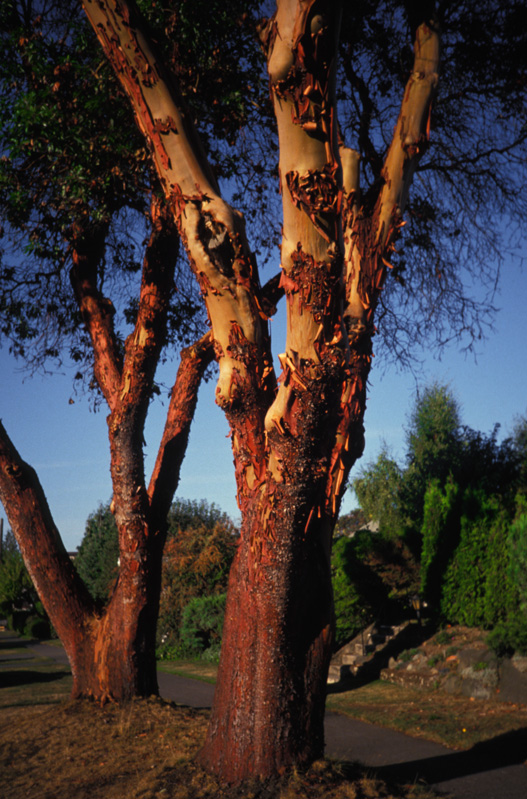
|
Madrona trees
|
| Madrona trees are emblematic of Seattle bluffs. They look so dazzlingly different. Above all it's their orange-red, peeling bark. It helps that their trunks are often sinuous and leaning in an attractively irregular fashion. Their evergreen, glossy leaves are also distinctive. The creamy little flowers of April and May, and the autumnal red berries, are seasonal highlights. But beauty aside, right now many madronas are sick, and people are worried. |
| It should be obvious, but has been proven by at least one study, that madronas in undisturbed wild areas are --on average-- healthier than those heavily affected by people and pets. Our everyday activities add up to hurt the trees. We clear native groundcover vegetation away from the tree roots; we plant grass and other things; we irrigate; we compact the soil; our dogs piss against the trunks; we acidify the soil; we use chemicals; we injure the bark by carving, climbing, hitting it, etc. Air pollution can scarcely be inconsequential. |
| Given this array of harmful factors is it any wonder many trees look beat? Madronas have grown here since the last glaciation some 13,500 years ago. Their overall range extends from B.C. to southern California, pretty much hugging the coastline. Our madrona is known to botanists as Arbutus Menziesii. In B.C. folks use Arbutus as the common name. It is called madrone in California --and locally by out-of-touch writers and academics. |
| Well, more than a dozen other species of Arbutus or madrona exist --there is a Texas madrona, an Arizona one, a Mediterranean one, a Canary Island one, and several from Mexico. As a whole the genus favors limey or chalky soils rather than acidic ones. Since the genus likes alkaline soils, and perhaps Seattle's healthiest specimens are near the lower Duwamish River, where at least 3 cement factories exist, it makes me hypothesize as follows: Seattleites have acidified our soils and disturbed our trees so much that fungal pathogens now have an easier time (than in olden days) of infecting and seriously hurting madronas. It is also possible that people accidentally introduced some of the leaf spot, canker or root rot diseases harming madronas. |
If there are alkaline soils which inhibit these pathogens, or if madronas are naturally stronger and able to resist diseases when growing in soil they prefer --then we can study the soil carefully around healthy and unhealthy trees, to discover the key. I'd bet the soil's pH and mineral content, is far more important than such factors as air pollution, soil compaction, shade, moisture availability, etc.
(originally published in The Seattle Weekly, August 1997)
Back |
|
|

